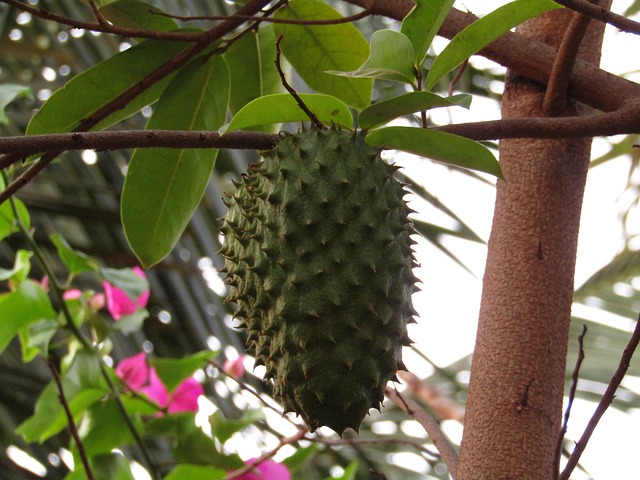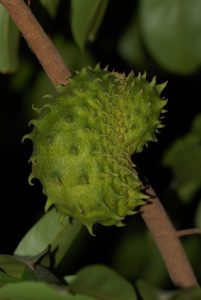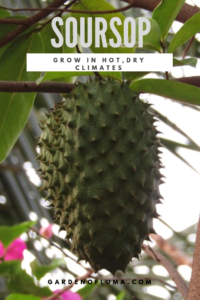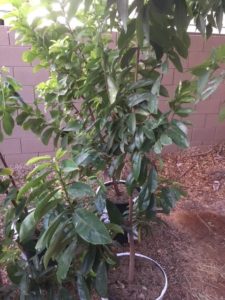Growing a Soursop Tree in Hot, Dry Climates

Soursop or Annona Muricata was one of those fruits that I had never even heard of before my fruit growing quest. I spotted fresh Soursop at a local ethnic market for $14.99lb, which was way more than I was willing to spend on a piece of fruit. I did end up finding some frozen Soursop at a much cheaper price and really liked the flavor. Some of the local Phoenix tropical fruit tree nurseries carry the Soursop tree, but I was always reluctant to purchase one.
When I started researching more about growing a Soursop tree, I learned that they were ultra-tropical.
Many of the fruit trees that I grow in the Arizona desert are sub-tropical trees, meaning that they can take a little bit of cold. Soursop isn’t one of those trees.
A Soursop tree starts going into survival mode when temps drop below 40 degrees Fahrenheit.
I notice the leaves on my Soursop tree will start turning black when it gets too cold outside.
Soursop trees are quick to shed their leaves when they get too cold and can be easily killed by temps below 35 degrees Fahrenheit.
Soursop Tree from Seed
Another thing I was concerned with when growing Soursop was the dryness of my climate. Being that Soursop is so tropical, I figured it needed that constant humidity for it to survive.
Taking all of these factors into consideration, I decided I didn’t want to waste my money on buying a Soursop tree, but I did order a few seeds.
While researching growing soursop, I found that most Soursop trees were grown from seed versus grafting practices.
Soursop trees grown from seed are reportedly highly likely to produce good quality fruit.
I germinated a couple seeds by soaking them overnight, than placing them in a moist paper towel in a Ziploc bag, while storing it in a dark, warm place.
The seeds took about 3-4 weeks to germinate, than I transferred them to cups with a soilless seed starter mix until the seedling starting producing some leaves.
After a few months, it was large enough to transfer to a larger pot and moved outdoors.

Soursop in Hot, Dry Desert Climate
Surprisingly, I have had a lot of success growing a Soursop tree in the Arizona desert. After two years, the tree is about 6 feet tall from seed.
The tree has the most growth flush during the spring months, but does grow continuously throughout the year, even when the temps soar over triple digits.
When we get extreme heat, the new growth tips can burn or be damaged, but overall the tree seems to take hot, dry climates well when cared for properly.
Fruiting
At the time of writing this post, my Soursop was a little over two years old from seed and hadn’t yet flowered.
It is uncertain if a Soursop Tree will be able to produce fruit in a hot, dry climate. Many things I’ve read indicate that Annona Muricata or Soursop likes high humidity when flowering for pollination.
Soursop is more of an experimental tree for hot, dry climates. Using a greenhouse or a creative way to increase humidity during flowering may help with successfully getting fruit set.
If not, the Soursop tree looks nice, and the leaves have a lot of reported health benefits.

Gardening Skill Level
I would rate growing Soursop more for the advanced gardener. It does seem to grow fairly well in a hot, dry climate, but you have to utilize the right micro-climate.
It can be challenging to get it through the winter time in areas that get below 40 degrees Fahrenheit, so if you plan to put it in the ground in marginal climates, it’ll be a challenge to keep it alive during the winter.
Suitable for Container Growing

Soursop is a great tree to grow in a container. I currently grow mine in a container and intend to keep it that way for the lifetime of the tree.
Since Soursop trees don’t tolerate cold, it’s much easier to bring it in a garage or house during cold snaps in a container.
Soursop trees tend to have shallow root systems, so they can handle growing in containers without quickly getting root bound.
As with all container grown fruit trees, use a soil mix that has good drainage. Check your drainage holes periodically to ensure proper drainage.
Soursop trees don’t like to be sitting in water, especially when it is cooler.
Planting Tips
The main thing to consider when planting is making sure it stays warm. Soursop seems to grow fairly well in a shady area in hot, dry climates.
I keep mine under the canopy of a large Ash tree during the hot summer months, so it does get quite a bit of shade.
It probably gets sun up until 10:00am, then dappled sun through the trees for the rest of the day. When temps start dropping under 90 degrees Fahrenheit consistently, I start moving it into full sun.
If you are going to plant in the ground, make sure it’s in a spot that is protected from frost and stays warm.
Watering
Soursop trees like steady water throughout the hot season, but don’t need to be overly moist like some fruit trees or edibles.
I’m not saying that it is drought tolerant, but it doesn’t need to be wet all the time. I slow down on the watering a lot in the cooler months, to be careful of root rot.
Feeding
I haven’t noticed a need for any sort of special care when it comes to feeding my Soursop tree.
I give it a steady dose of fish emulsion and liquid seaweed throughout the year, with an occasional top dressing of compost.
It seems to respond well to that type of feeding regimen and as long as it’s getting a steady food source, doesn’t seem like it’s a super heavy feeder.
Here are my recommended fertilizers and garden products.
Sun Exposure
Soursop likes a lot of sun in the winter months, because it needs all the warmth it can get. Otherwise, it is not a full sun plant during our scorching desert summer season.
Soursop will do best in hot, dry climates with morning sun and afternoon shade.
Some fruit trees tend to grow slower when given too much shade, but from my experience with Soursop, it seems to continue to grow steady with a good amount of shade if the temps are high.

Potential Problems
I have had very little issues when it comes to pests with Soursop.
I’ve rarely seen any bugs on the tree. Hot, dry winds can be a problem for Soursop trees, as the leaves tend to get shredded in hot winds. So, it could be beneficial to keep the tree in a protected area.
I’ve found that a Soursop tree seems to do well when placed wedged into other trees, not just out in the open by itself.
Please comment below anything you enjoyed about this post or your experiences growing Soursop outside of the tropics.

I don’t know if you posted an update to your soursop tree experience. As it is 2019 now, just curious how it’s going.
Meggan, It’s a little beat up from the cold, but still doing fairly well. I think it will bounce back as we warm up.
Very cool! Any flowers or fruit growing on your soursop yet? What size pots are they in?
Not on the Soursop, but I’m getting fruit on the Sugar Apple. They’re currently in 15 gallon containers.
Congratulations on getting fruit on your sugar apple! I may have to give sugar apples a taste when it’s in season and then try to grow my own when I get the chance. Based on your own experiences with the soursops cold hardiness, what temperature would you recommend bringing it indoors to avoid defoliation or damage to the soursop trees? Thanks for replying!
They can be pretty sensitive, especially if it’s cold and windy. I try to bring mine indoors when night temps start going below 45. I wasn’t great about keeping up with it and the tree did endure some colder temps in the mid 30’s, but the leaves were pretty beat up and some dropped. Here in the Phoenix, Arizona area our cold snaps are brief in the early morning hours.
I completely forgot to mention that I just successfully germinated some soursop seedlings and I’m excited to grow them in my North Texas Climate. Thanks again!
Awesome, good luck!